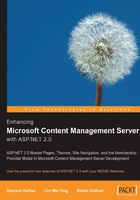
What This Book Covers
Chapter 1 walks you through the installation and configuration of MCMS 2002 Service Pack 2 (SP2), along with SQL Server 2005 and Visual Studio 2005 on a single developer workstation. There are two approaches to setting up a development environment for SP2: an upgrade from a previous SP1a installation or starting from scratch and building a fresh installation including SP2. We will cover both approaches in this chapter.
In Chapter 2 we spend some time getting familiar with the MCMS Service Pack 2 development environment, which is slightly different from what we are used to with previous versions of MCMS and Visual Studio. We will cover these changes and a number of tips for working within the SP2 development environment, such as the creation of custom MCMS Visual Studio 2005 templates.
Chapter 3 introduces you to one of the best new features introduced with ASP.NET 2.0, master pages, which allow developers to enforce common layout and behavior across pages within an application. While at first pass many master pages concepts are similar to those of MCMS templates, there are a number of benefits to be gained by taking advantage of master pages within MCMS applications. This chapter
provides an overview of the benefits of using master pages and a step-by-step guide for implementing them in your MCMS applications, where they become master templates!
Chapter 4 covers the new ASP.NET 2.0 Navigation provider model and controls, and how to integrate them into your MCMS applications. Developing site navigation controls is an exercise that often leaves developers in a dilemma. Early versions of Visual Studio did not provide any ready-to-use navigation controls. Developers had to choose between spending many hours building controls from scratch or expand project budgets to purchase shrink-wrapped software.
In Chapter 5 we will see how a common look and feel can be applied efficiently to an MCMS site by using themes. We will create skins and cascading style sheets and demonstrate how they work together to define the appearance of a site. Finally, we will discuss an essential customization required for themes to work correctly in an MCMS site.
Chapter 6 covers the Membership Provider Model, one of the key new concepts introduced with ASP.NET 2.0, which makes it significantly easier to develop web applications that utilize third-party or custom membership stores. In addition ASP.NET 2.0 ships with a number of authentication controls related to role membership, which vastly reduce the amount of code required to implement forms authentication and associated functionality in your applications. This chapter shows how to use these features to improve the implementation of Forms Authentication and provides a more elegant solution for "account mapping" scenarios whereby authentication takes place against an external store and the accounts are mapped to Windows accounts for the purposes of MCMS authorization.
In Chapter 7 we present a number of tips along with code samples for working with ASP.NET 2.0 and MCMS SP2, and offer implementation advice for those considering migration to the upcoming Microsoft Office SharePoint Server 2007.